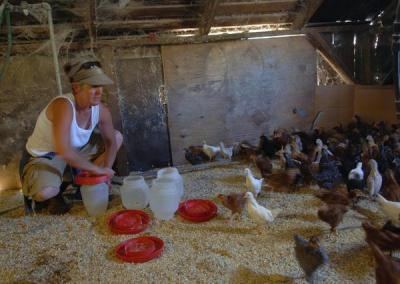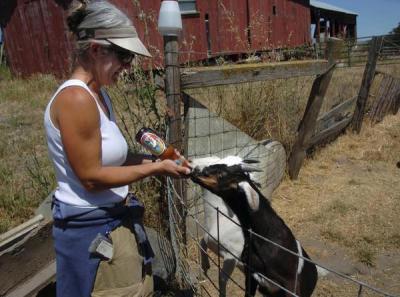A banner year for Marin farms with record revenues for 2007

Rob Rogers
June 29, 2008, Marin IJ
ASK TOMALES RANCHER Liz Cunninghame why Marin's farmers achieved record revenues in 2007, and she'll tell you about her golden geese.
"We've had chickens and turkeys for several years, and we're trying heritage geese this year," said Cunninghame, whose Clark Summit Farm supplies organic eggs and poultry to San Francisco gourmands. "They're really cool, and unlike chickens, they don't eat a lot of grain - and the cost of grain is getting to be a big deal. They like grass, so you can actually use them to weed your fields.
"And as they move around, they help fertilize."

Clark Summit Farm was a dairy ranch in the days when Cunninghame's father managed the property, and there are still a few cows ambling through its pastures. These days, however, the West Marin farm looks more like it did in her grandfather's day, with a variety of poultry, pigs, goats, fruit trees and vegetables.
"The agricultural community is moving into different activities," said Marin Agricultural Commissioner Stacy Carlsen. "Farms that performed one activity in the past are now looking at two or three things at the same time to help stabilize their crop report."
Crop diversity isn't the only factor that pushed Marin's gross agricultural value to $67.1 million in 2007 - the "highest gross values we've had in the history of production in this county," Carlsen said. But it's one of the reasons Carlsen says Marin's farm economy will continue to do well in the future.
"Our system has been grass-based, primarily dairy," Carlsen said. "Historically, the cycle of prices swings up and down, and I don't anticipate that it will stay at the current high level for indefinite periods. But we've had other production that I'm excited about - sheep and lambs, as well as an increase in poultry."
Milk remains the heart of Marin's farm production, accounting for about 58 percent of the county's total agricultural output. In 2006, the county's gross milk value fell by 13.3 percent, or $4.2 million. In 2007, according to the county's latest agricultural report, it rose by 54 percent, or $11.9 million. The county produced about 23.9 million gallons of milk in 2007.
"Compared to 2006, when dairy farmers were getting $12.25 per hundredweight (hundred pounds of milk), the price of milk rose to $18.86 in 2007," said Ellen Rilla, director of the University of California Cooperative Extension in Novato. "Fluid milk earned the county $27 million in 2006 and almost $39 million in 2007."
Yet milk wasn't the only Marin crop to report a banner year.
"We have both new poultry operations and existing operations that are increasing production," Rilla said. "The total dollar value of those chickens has gone from $2.3 million to $2.7 million."
Marin's poultry operations are still small-scale compared with those in other counties. But rancher Cunninghame says that's a selling point.
"There's been a huge demand for our eggs, chickens and turkeys," Cunninghame said. "We're selling out all the time - 22 cases of eggs a week. We get calls from the Rainbow Grocery in San Francisco wanting to know when we're coming."
Unlike large commercial poultry operations, Cunninghame's 1,600 laying hens spend their days outside and only produce eggs in season. Taking care of the chickens is a labor-intensive operation, she said, particularly keeping them safe from coyotes, foxes, hawks and bobcats who leap the electric fence that surrounds the chicken coop.
"There's a lot of wildlife on the farm," Cunninghame said. "It's expensive to raise chickens the way we do. But people who know about pastured, organic eggs want them" and are willing to pay up to $7.50 a dozen for them, she said.
Marin's aquaculture revenues remained steady, rising by $38,753 to $2.6 million. Cattle and calf production dipped by $26,269 to $7.83 million, while the actual number of cow and calf pairs dropped from 16,616 to 15,656. The most dramatic drop in livestock products came for wool, which fell from $42,186 in 2006 to $21,090 in 2007 - although sheep and lambs rose by $85,564 to $1.14 million.
Field, fruit and vegetable production rose by $917,677, or 12.5 percent. Hay proved especially valuable; the value of grass hay grew from $144,212 to $275,011 while oat hay jumped from $19,600 to $64,472. Marin's wine grapes climbed in value by 24.7 percent, even as its tonnage decreased by 33 percent. Nursery crops rose by $189,187 or 41.7 percent.
Although Marin's crop report doesn't distinguish between organic and other methods of farming, many of Marin's growers have shifted to organic methods, which boosted the county's agricultural earnings, Rilla said.
But while Marin's farmers and ranchers enjoyed high prices for their products in 2007, they also paid premiums for corn, hay and other feed - a problem Cunninghame and others are working to address.
"We'd like to start incorporating milk into our chickens' diet as a substitute protein for soybeans, which are really expensive," the Tomales rancher said. "They may be organic, but they're coming from China, and they have a lot of miles on them. We'd like to figure out ways to produce our own feed. Ideally, a couple of years down the road, we'll be self-sufficient."



